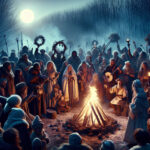The winter season is a time for cozy fires and family gatherings, but for many it is also a time to reflect on ancient traditions and beliefs. The pagan winter is a time for ancient cultures to honor the changing of the season and to reflect on their spiritual beliefs. This article will explore the history of how the pagan winter is celebrated and what it means to those who observe it. We will look at the customs associated with this special time of year, the spiritual significance of the winter solstice, and how it can be celebrated today.

Pagan Winter is a time of celebration and reflection in many pagan cultures. It is a time to celebrate the return of the Sun and the lengthening of days, as well as a time to reflect on the past year and plan for the future. During this season, many people take part in activities such as lighting candles, decorating with holly, and feasting. Pagans also use the time to honor their ancestors, the gods and goddesses, and the natural world.
What Is Pagan Winter?
Pagan Winter is an ancient religious holiday, celebrated by many pagan cultures around the world. It is also known as Yule, Midwinter, and the Winter Solstice. It is the shortest day of the year, when the sun appears at its lowest point in the sky and the days begin to get longer. This day is seen as a turning point, when the sun begins to rise and the days become longer, with the promise of warmer weather to come.
What Do Pagans Do During Pagan Winter?
Pagans celebrate Pagan Winter in a variety of ways, depending on their beliefs and traditions. Common activities include lighting candles, decorating with holly, and feasting. Many also take part in activities such as ritual baths, divination, and spell-casting. Pagan Winter is also a time for honoring the gods and goddesses, ancestors, and nature.
What Is the Meaning of Pagan Winter?
Pagan Winter is a time of reflection and celebration, when pagans take time to reflect on the past year and plan for the future. It is a time to celebrate the return of the sun and the lengthening of days, and to honor the gods, goddesses, and the natural world. It is also a time to remember and celebrate our ancestors, and to give thanks for the blessings of the past year.
How Do Pagans Celebrate Pagan Winter?
Pagans celebrate Pagan Winter in a variety of ways, depending on their beliefs and traditions. Common activities include lighting candles, decorating with holly, and feasting. Many also take part in activities such as ritual baths, divination, and spell-casting. Others may gather for a ritual bonfire or a sacred gathering to celebrate the season.
What Are Some Traditional Pagan Winter Foods?
Eggs and dairy products are traditional foods for the season. These foods are believed to represent fertility, renewal, and the promise of new life. Other traditional foods include roasted root vegetables, grains, and honey-based desserts.
What Are Some Pagan Winter Rituals?
Many pagans take part in rituals to celebrate the season. These may include invoking the gods and goddesses, honoring the ancestors, or giving thanks for the blessings of the past year. Other rituals may include divination, spell-casting, and meditation.
What Is the History of Pagan Winter?
Pagan Winter has been celebrated for centuries by various pagan cultures around the world. It is believed to have its roots in the ancient Celtic and Germanic traditions, which celebrated the winter solstice as a time of rebirth and renewal. Over time, other cultures have adopted and adapted these traditions, creating their own rituals and celebrations.
How Can I Celebrate Pagan Winter?
Pagan Winter is a time to celebrate the return of the sun and the lengthening of days. You can celebrate the season by lighting candles, decorating with holly, and feasting. You can also take part in rituals such as invoking the gods and goddesses, honoring the ancestors, or giving thanks for the blessings of the past year. You can also take part in activities such as divination, spell-casting, and meditation.
The Pagan Winter is a time of celebration and reflection. It is a time to honor the gods and goddesses of old and to appreciate the beauty of the season. It is a time to come together with family and friends to celebrate the joy of life and to give thanks for the blessings of the year. It is a time to enjoy the cold and the darkness, and to appreciate the natural world and the beauty of nature. It is a time to remember the past and to look forward to the future. The Pagan Winter is a time of joy and hope, a time to celebrate life and to give thanks for all that we have. Let us embrace the Pagan Winter with reverence and gratitude, and use it to bring us closer to our gods, our families, and ourselves.





